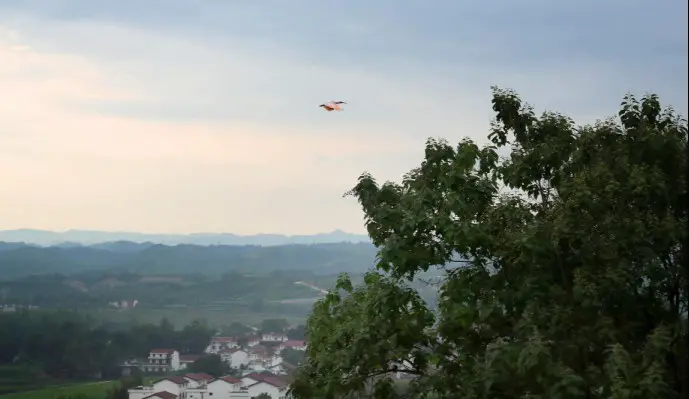By Yuan Taoxiong, People's Daily

A crested ibis flies over a village in Yangxian county, Hanzhong, northwest China's Shaanxi province, Aug. 1, 2020. (Photo by Xu Congjun/People's Daily Online)
The Qinling Mountains, a natural boundary between China's north and south, is an important region of water conservation for the Yellow River and Yangtze River basins. It is home to rich biological resources.
In recent years, northwest China’s Shaanxi province has taken ecological protection and restoration in the Qinling Mountains as a priority, where ecology of human-nature harmony has taken shape.
In a wild crested ibis rescue and breeding center in Shaanxi Hanzhong Crested Ibis National Nature Reserve on the southern slope of the Qinling Mountains, there is a net cage covering an area of 10 mu, or nearly 0.67 hectares. The gigantic net cage is where crested ibises are trained before they are released into the wild.
After 40 years of efforts, the national nature reserve, mainly in Yangxian county, Shaanxi’s Hanzhong city, has achieved remarkable progress in the protection of crested ibises. At present, there are over 7,000 crested ibises on the nature reserve, and the species has expanded its range overseas.
So far, Shaanxi has established five artificial breeding centers for the rare bird species and developed four populations to be released into the wild, in an attempt to reintroduce the artificially bred crested ibises to their traditional habitats. The habitats of wild crested ibises now cover 16,000 square kilometers, from less than 5 square kilometers when they were discovered.
Apart from the expanding population of crested ibises, the number of key wild animals under national protection is also increasing, such as giant pandas, golden snub-nosed monkeys and takins.
Besides, there are also achievements in plant protection. Primula filchnerae, a species that once had been considered extinct, was rediscovered in Yangxian county in 2015. Last year, Kingdonia uniflora, a species of perennial herbs under China’s first-class protection, was discovered for the first time under an altitude of 2,700 meters in the Taibai Mountain, the main peak of the Qinling Mountains. Recently, Cardiocrinum cathayanum and Allium tsinlingense were found for the first time in the Qinling Mountains.
Shaanxi has been taking ecological conservation as a top priority in recent years, and implemented a series of restoration projects such as protecting natural forests, constructing nature reserves and returning farmland to forest and grassland. A total of 116 reserves have been built in the Qingling Mountains, covering a total of 9,200 square kilometers. Over 75 percent of the ecosystems and over 70 percent of wildlife species in Shaanxi province have been protected in the reserves.
A digital monitoring network has been built in the Qinling Mountains, which employs internet of things monitoring, thermal imaging recognition, drone patrol and a smart eco-protection system. These technologies form a three-dimensional remote sensing monitoring system that helps to safeguard the ecology in the Qinling Mountains.
According to forestry authorities in Shaanxi province, more than 70 percent of wildlife species in the province have been put under protection, and the population of species under key protection has been on a constant rise.
The population of wild giant pandas in Shaanxi increased from 109 in the 1980s to 345 at the time of China’s fourth national giant panda survey. The number of golden snub-nosed monkeys hit 5,900, and the population of takins exceeded 5,000. Chinese yew, Chinese dove-tree, Kingdonia uniflora, Psathyrostachys huashanica, Larix chinensis and other endangered plant species have all been effectively protected.
The plan to create the Qinling Mountains National Park was officially approved in October, 2021. It will further enhance the ecological efforts in the Qinling Mountains. To protect the authenticity and integrity of natural ecosystems in the mountain range, a science-based protection and management mechanism centering is being developed, with a focus on the ecological restoration of the Qinling Mountains.
In recent years, northwest China’s Shaanxi province has taken ecological protection and restoration in the Qinling Mountains as a priority, where ecology of human-nature harmony has taken shape.
In a wild crested ibis rescue and breeding center in Shaanxi Hanzhong Crested Ibis National Nature Reserve on the southern slope of the Qinling Mountains, there is a net cage covering an area of 10 mu, or nearly 0.67 hectares. The gigantic net cage is where crested ibises are trained before they are released into the wild.
After 40 years of efforts, the national nature reserve, mainly in Yangxian county, Shaanxi’s Hanzhong city, has achieved remarkable progress in the protection of crested ibises. At present, there are over 7,000 crested ibises on the nature reserve, and the species has expanded its range overseas.
So far, Shaanxi has established five artificial breeding centers for the rare bird species and developed four populations to be released into the wild, in an attempt to reintroduce the artificially bred crested ibises to their traditional habitats. The habitats of wild crested ibises now cover 16,000 square kilometers, from less than 5 square kilometers when they were discovered.
Apart from the expanding population of crested ibises, the number of key wild animals under national protection is also increasing, such as giant pandas, golden snub-nosed monkeys and takins.
Besides, there are also achievements in plant protection. Primula filchnerae, a species that once had been considered extinct, was rediscovered in Yangxian county in 2015. Last year, Kingdonia uniflora, a species of perennial herbs under China’s first-class protection, was discovered for the first time under an altitude of 2,700 meters in the Taibai Mountain, the main peak of the Qinling Mountains. Recently, Cardiocrinum cathayanum and Allium tsinlingense were found for the first time in the Qinling Mountains.
Shaanxi has been taking ecological conservation as a top priority in recent years, and implemented a series of restoration projects such as protecting natural forests, constructing nature reserves and returning farmland to forest and grassland. A total of 116 reserves have been built in the Qingling Mountains, covering a total of 9,200 square kilometers. Over 75 percent of the ecosystems and over 70 percent of wildlife species in Shaanxi province have been protected in the reserves.
A digital monitoring network has been built in the Qinling Mountains, which employs internet of things monitoring, thermal imaging recognition, drone patrol and a smart eco-protection system. These technologies form a three-dimensional remote sensing monitoring system that helps to safeguard the ecology in the Qinling Mountains.
According to forestry authorities in Shaanxi province, more than 70 percent of wildlife species in the province have been put under protection, and the population of species under key protection has been on a constant rise.
The population of wild giant pandas in Shaanxi increased from 109 in the 1980s to 345 at the time of China’s fourth national giant panda survey. The number of golden snub-nosed monkeys hit 5,900, and the population of takins exceeded 5,000. Chinese yew, Chinese dove-tree, Kingdonia uniflora, Psathyrostachys huashanica, Larix chinensis and other endangered plant species have all been effectively protected.
The plan to create the Qinling Mountains National Park was officially approved in October, 2021. It will further enhance the ecological efforts in the Qinling Mountains. To protect the authenticity and integrity of natural ecosystems in the mountain range, a science-based protection and management mechanism centering is being developed, with a focus on the ecological restoration of the Qinling Mountains.
 Menu
Menu
 Biodiversity enhanced in China's Qinling Mountains
Biodiversity enhanced in China's Qinling Mountains
















